Choosing the Right Dining Set for Your Space
Choosing the Right Dining Set for Your Space


Selecting the right dining set for your space is crucial, as it not only fills one of the primary functional needs of a home but also plays a significant role in defining the aesthetic of your dining room. The dining space is usually where family and friends gather to share meals, celebrate occasions, or even engage in casual conversations. Therefore, choosing materials, shapes, and sizes that cater to your lifestyle, are durable, add charm to your space, and meet your specific requirements is essential. This guide will help you through the process of choosing the perfect dining table, one of the most integral pieces of furniture for your home, keeping critical aspects like space, shape, size, materials, and chairs in mind. Using these elements, you'll be able to create an inviting and functional dining space.
Assessing Your Dining Space
Before diving into purchasing a dining set, take a moment to evaluate your dining space. Understanding the dimensions of your dining room can help determine the most suitable dining table size and shape, it will allow you to consider 4 chair dining sets vs 6 chair dining sets, to the big 12 chair dining sets and how they’ll impact your space, or open up your space. Consider the room's layout, keeping in mind other furniture pieces or design elements present. Remember, your dining table should blend seamlessly with your space without overpowering it or making it feel cramped. Here's a general guideline to follow when choosing the right size for your dining set.
Measure the space
When measuring your dining space, consider the table's length and width you plan on purchasing, also accounting for extra space for chairs and movement. Here's a simple guide:
Room Length and Width: Measure the length and width of your dining space. Subtract around 90cm from both measurements to account for chair space and walking area around the table.
Proposed Table Size: Determine the ideal length and width of your proposed table. This should comfortably fit within the dimensions calculated above.
Space for Chairs: Allow at least 60 cm of space per chair. This accounts for seating as well as elbow room.
Walking Space: Ideally, there should be at least 90cm of clear space around the table, ensuring people can move freely without feeling cramped.
By taking these measurements, you can ensure that your new dining table will fit perfectly into your dining space.
Choosing the Right Shape for Your Table
The shape of your table can dramatically affect the ambience of your dining space. From round to square to rectangular tables, each shape lends a different aesthetic and functionality. Factors such as room shape, your personal style, and how you plan to use the table play a crucial part here. Let's delve deeper into the benefits and drawbacks each table shape offers, including the use of oval tables for a harmonious flow and encouraging conversation.
Round tables
Round dining tables are ideal for smaller spaces and where sociability is key. They enhance conversations by allowing everyone to face each other, eliminating the head of the table and creating a sense of equality. Here are some key points to consider:
● Round tables lack corners, effectively providing more space for movement and facilitating seating flexibility.
● They can make rooms feel fuller and more convivial, as the circular design encourages interaction and conversation.
● In small rooms, a round table can give an impression of spaciousness due to its compact footprint.
● If you regularly host large get-togethers, consider extending round tables that offer extra space when needed.
Square tables
Square dining tables work well in square rooms. They project a balanced and organised look and are ideal for seating four people. Here are some aspects to consider about square tables:
● Square tables efficiently use space in small, square rooms and provide a compact eating area.
● They can be easily positioned against a wall or in a corner, making them suitable for rooms with limited space.
● If your guest list expands, two square tables can be effortlessly paired to form a larger rectangular table.
● However, for larger gatherings, square tables might feel cramped and limit interaction as people will be seated farther apart.
Rectangular tables
Rectangular tables are a traditional choice and fit comfortably in most rooms. They are best suited for long, narrow rooms and tend to offer more seating space. A few points to note:
● Rectangular tables allow for a clear designation of a 'head' of the table, which may be fitting for formal settings.
● They offer ample space to accommodate food serving dishes in the middle while still leaving plenty of room for diners.
● While perfect for large gatherings, they might feel excessively large for intimate dinners.
● A potential drawback is mobility issues due to the length of the table and space required on all sides for chairs.
Selecting the Perfect Size
Once the table's shape is decided, figuring out the size is the next milestone. The size should strike a balance between accommodating enough people comfortably and fitting the room proportionately without crowding it. Take into account the number of regular diners, potential guests, and available space. An 8-seater table is perfect for those with a large family or if you like to entertain, making it an ideal option for Sunday roasts or celebratory meals. Let's get into the specifics.
Balancing table size with room size
Balance is the key to interior design. A dining table, being a significant piece of furniture in your home, should add balance to your dining space. If your room is large, go for a larger table, creating a sense of proportion and filling the space suitably. For smaller spaces, a compact table is ideal. It would delicately fit into your room without overpowering it, leaving enough space for movement. Having too large a table will make the area feel cramped, while too small a table can give a sense of under-utilisation of space. Thus, adequately balancing the table size with the room size is vital in creating an inviting and comfortable dining experience.
Accounting for seating and legroom
While deciding your table size, accounting for seating and legroom is essential. Considering the table's dimensions alone might lead to an overcrowded table and cramped seating. Here are key things to consider:
Seating Space: Allow a seating space of about 60 cm per person to ensure a comfortable dining experience.
Table Height: Standard table height ranges between 70-75 cm, but consider the height of your dining chairs, too. The distance from the chair seat to the underside of the table should ideally be around 30 cm to provide sufficient legroom.
Table Overhang: If you believe guests might be seated at the ends of the table, choose a design with an overhang (extra surface extending beyond the table's base) to ensure that they have enough legroom.
Choosing the right size of the table and considering seating and legroom will ensure a comfortable dining experience.
Material Selection
Another crucial element in choosing the right table is deciding on the material. The material of your dining table is not only its look but also its resilience. From wood to glass to metals and mixed materials, each material has its own aesthetic and needs specific care and maintenance. Now, let's delve into the characteristics of each material type, including the very durable ceramic, to help you make an informed decision.
Wood
Wooden dining tables are a traditional choice and provide a warm, organic feel to your dining room. They come in a variety of hardwood types, such as oak, walnut, or mahogany, which are all highly durable and long-lasting.
● A wooden table adds an element of homeliness and earthiness to your space.
● They are sturdy and can sustain rough usage and, to some extent, resist scratches.
● The great advantage of wooden tables is that they can be refinished or painted in case of wear and tear.
● However, keep in mind that real wood can warp in humid environments, and some finishes can show water rings.
Glass
Glass tables offer a modern appeal and can effortlessly fit into any decor style. They give off a sleek, clean look and create an illusion of more space, making them ideal for small dining areas.
● A glass table top visually lightens a room and complements any colour palette.
● Glass is hassle-free to clean. However, it can show fingerprints and needs regular maintenance.
● When considering a glass table, be sure it's made from tempered safety glass that is significantly stronger and safer than regular glass.
● While clear glass is a popular choice, tinted and frosted glasses can add a distinct aesthetic to your room.
Metal
Metal dining tables are a sturdy and sleek choice. They lend a modern, contemporary feel to your dining space and can endure years of use without showing wear.
● Metal tables are highly durable and less susceptible to stains and water damage, making them a practical choice.
● They seamlessly fit into an industrial or minimalist decor style.
● Metals vary from stainless steel to wrought iron, each offering a unique finish and aesthetic.
● Some metals, such as iron, may rust over time if not properly treated, so keep an eye out for tables with a rust-resistant finish.
Mixed Materials
Mixed material tables offer the best of all worlds by combining various materials like wood, glass, and metal. These tables make a striking statement and showcase an interesting interplay of textures, colours, and finishes.
● Mixed material tables offer an aesthetically balanced look. For instance, a wooden top on industrial metal legs can add warmth and a rustic charm to your space.
● They allow for versatile styling and bring an exciting element to your dining space.
● However, they may require varied care depending on the type of material used.
● Mixed material tables are a fantastic way to bring a little extra character and uniqueness to your dining room.
Choosing the Right Chairs
While focussing on the table, don't forget about the chairs – they are crucial in bringing your dining space together. Chairs should provide comfort, complement the aesthetics of your table, and fit well in the space available; the dining experience can be dampened if it feels overcrowded at the table. So, let's discuss the considerations you should make when selecting your chairs, including the base of the table, to ensure that the table legs do not interfere with seating.
Size and shape compatibility
The size and shape of your chairs should mirror your table to maintain a consistent aesthetic and comfortable seating arrangement.
Chair Height: Relative to your table, your chair height should ideally provide around a 30 cm gap from the seat to the underside of the table.
Chair Width: Allocate at least 60 cm to each chair to avoid overcrowding.
Chair Style: The shape and style of chairs should complement your table. For instance, curved chairs pair well with a round table.
Also, remember that chairs vary dramatically in their visual weight. Lighter, slender chairs will complement a heavier, chunkier table, while robust, upholstered chairs would go best with a light and minimalistic table for balance.
While every home and preference is unique, maintaining a sense of balance is key. The right dining set will complement your style, fit well within your space, serve its functional purpose effectively, and last for many years. And remember, the dining table is not just a piece of furniture; it's the hub of delicious meals, conversation, laughter, and togetherness. So take your time, weigh all options, and choose wisely.
Remember, the result of this exercise is more than aesthetics; it's about making your home more inviting and comfortable to enjoy those intimate family meals and special gatherings with friends. Happy dining!
